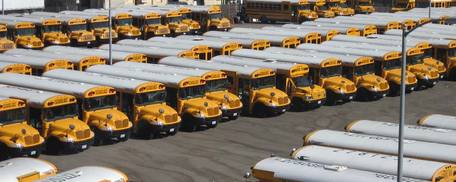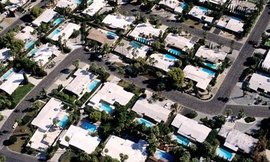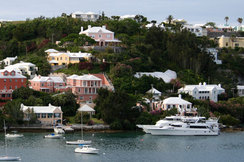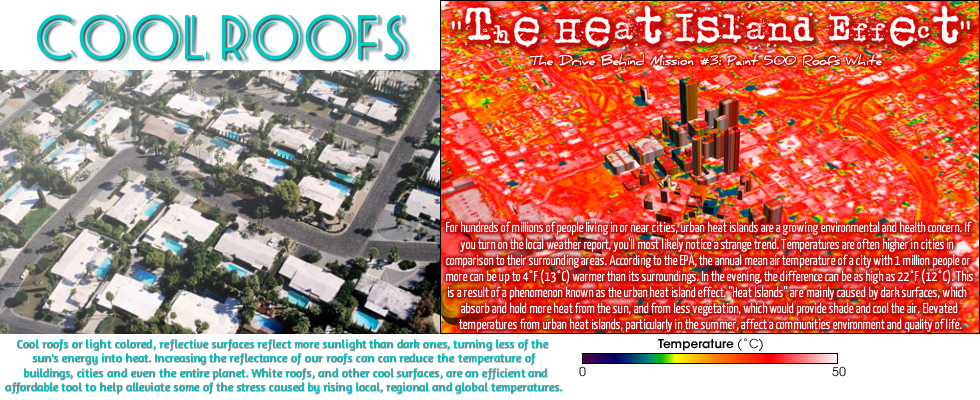
The Drive Behind Mission #3: Cool Roofs
The Benefits of Cool Roofs
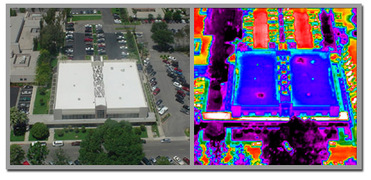
- Reduce the roof surface temperature by up to 100 degrees Fahrenheit, thus reducing the heat transferred into the building below. A white or reflective roof typically only increases 10-25 degrees Fahrenheit above ambient temperatures during the day. Learn more.
- Save on annual electricity bills by reducing summer air conditioning costs. Creates an average of 20% savings, but can reach over 40%
and there have even been electrical savings recorded nearly up to 50%. Learn more.
- Significantly cut greenhouse gas emissions and combats global climate change by reducing energy needs and cooling cities and the world. This is done through principles of solar radiation management and geoengineering, which show that cool roofs are not only used to reflect solar energy but emit infra-red radiation to cool the planet and reduce global warming. Learn more.
- Reduce the "Heat Island" effect. Learn more.
- Save peak electricity demand costs. Learn more.
- Reduce roof maintenance and replacement expenses by extending roof life. Learn more.
- Increase indoor comfort by the reduction of infrared conversion from visible light. Learn more.
- Reduce air pollution. Learn more.
- Increase the thermal conductivity of the roofs insulation. Learn more.
- Receive utility rebates in some locations. Learn more.
- Maintain aesthetics of a roof that performs and looks good. Learn more.
- Increase the life expectancy of the buildings cooling equipment. Learn more.
- Reduce smog formation. Learn more.
- Are an effective alternatives to bulk attic insulation in humid tropical and sub tropical climates. Bulk insulation can be entirely replaced by cool roofing systems. Learn more.
- Reduce roofing waste added to landfills. Learn more.
10%heats the environment
8%heats the city air
80%is reflected
1.5%heats the building
38% heats the atmosphere
52% heats the city air
5% is reflected
4.5% heats the building
Easy. Cheap. Efficient.
If all urban, flat roofs worldwide were whitened, the reduction in carbon emissions would be 24 Gigatonnes, or equivalent to taking 300 million cars off the road for 20 years. Learn more.
The latest research shows that cool roofs and pavements can help cool the entire planet. Permanently retrofitting urban roofs and pavements in the tropical and temperate regions of the world with solar-reflective materials would have an equivalent effect on global temperatures as stopping the emissions of 44 billion tonnes of CO2, or over one year’s worth of humanity’s CO2 emissions.
Pavements and roofs comprise approximately 60% of city surfaces. Cool roofs and cool pavements can help reflect away the sweltering temperatures of summer urban heat islands, improving air quality and comfort. Widespread installations of cool roofs and pavements can reduce summer air temperatures in cities by 2 to 3 degrees Celsius (4 to 5 degrees Fahrenheit).
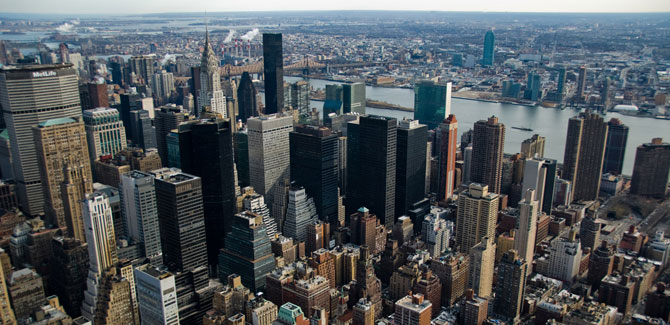
Image: Patrick Theiner, Creative Commons
Image Credit: Patrick Theiner, Creative Commons
- A higher peak electricity demand. Learn more.
- Higher utility bills. Learn more.
- A potentially overburdened power grid. Learn more.
- Increased greenhouse gas emissions. Learn more.
- Raised electricity production costs. Learn more.
- Intensified "heat island" effect. Learn more.
- Increased cooling energy. Learn more.
- Weaker roof aesthetics and thermal conductivity of roof insulation. Learn more.
- A reduction in indoor comfort. Learn more.
- Increased air pollution. Learn more.
- Increased ground-level ozone and smog formation. Learn more.
- An acceleration in the deterioration of roofing materials. Learn more.
- Increased roof maintenance costs. Learn more.
- Higher levels of roofing waste sent to landfills. Learn more.
- Increased global warming and climate change. Learn more.
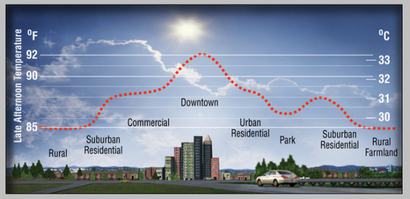
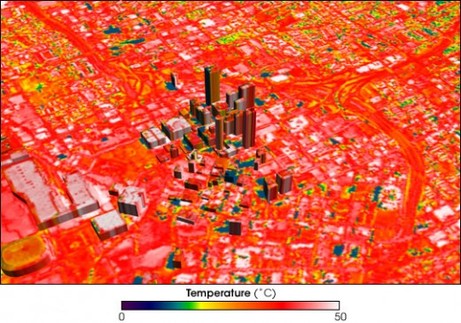
- Increased energy consumption : Higher temperatures in the summer increase energy demand for cooling and adds great pressures to the electricity grid during peak periods of demand. One study estimates that the heat island effect is responsible for 5-10% peak electricity demand for cooling buildings in cities.
- Compromised human health and comfort : Higher air pollution levels and warmer days and nights contribute to general discomfort, respiratory difficulties, non-fatal heat strokes, heat cramps and exhaustion and heat related mortality.
- Elevated emissions of air pollutants and greenhouse gases : Increased energy demands generally result in greater emissions of air pollutants and greenhouse gas emissions from power plants. Higher air temperatures also encourage the formation of ground-level ozone.
- Impaired Water Quality : Hot pavement and rooftop surfaces emit massive excess heat to stormwater, which drains into storm sewers and raises water temperatures as it is released into streams, rivers, ponds, lakes and oceans. These rapid temperature changes are stressful and damaging to aquatic ecosystems.
- Perhaps the worst result of the heat island effect is the number of heat related deaths . The National Oceanic and Atmospheric Administration reports that heat is usually more deadly in the U.S. and typically kills more people each year than hurricanes, tornadoes, floods and lightning put together.
New York Times: White Roofs Cut Energy Costs
What About Winter?
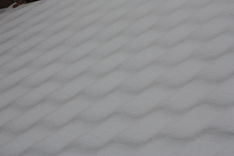
Cool roofs are not just flat and white. There are many options for cool roofs, including cool asphalt shingles. Learn more.
- Cool Roof Rating Council
- Heat Island Group
- Global Cool Cities Alliance
- U.S. Department of Energy
- New York Times - Environment
- Mother Earth News
- Mortgage News Daily - The Green Home
- LBNL Heat Island Group
- Cool California
- Cool Roofs and Title 24
- New York City Cool Roofs
- Program
- White Roof Project
- European Union Cool Roofs Council
- NYC’s “Cool It Yourself” Cool Roof Kit
- US Department of Energy Guidelines for Selecting Cool Roofs
- New York City’s cool and green roof manual
- Reducing Urban Heat Islands: Compendium of Strategies: Climate Protection Partnership Division in the U.S. Environmental Protection Agency’s Office of Atmospheric Programs, October 2008.
- Cool Roof Requirements Under the 2008 Building Energy EfficiencyStandards: California Energy Commission, Blueprint Magazine , April-May 2010
- Evolution of Cool-Roof Standards in the US: Hashem Akbari, Ronnen Levinson, Advances in Building Energy Research, Volume 2, 2008
- White Roofs Cool the World, Directly Offset CO2 and Delay Global Warming: LBNL Heat Island Group, Research Highlights, November 10, 2008
- Cool Colored Roofs to Save Energy and Improve Air Quality: LBNL Heat Island Group, (International Conference, “Passive and Low-Energy Cooling for the Built Environment,” Santorini, Greece, May 2005)
- Beyond White: Advances in Cool Colors: LBNL Heat Island Group, the Building Envelopes Program at Oak Ridge National Laboratory, Concordia University
- Regional climate consequences of large-scale cool roof and photovoltaic array deployment: Millstein, D. et. al. Environmental Research Letters, July 2011
- Radiative Forcing and Temperature Response to Changes in Urban Albedos and Associated CO2 Offsets: Akbari, H. et. al. Environmental Research Letters, January 21, 2010
- Potential Benefits of Cool Roofs on Commercial Buildings: Conserving Energy, Saving Money, and Reducing Emission of Greenhouse Gases and Air Pollutants: Levinson, R. and Akbari, H. Energy Efficiency, March 14, 2009
- Global Cooling: Increasing World-Wide Urban Albedos to Offset CO2: Hashem Akbari, Surabi Menon, Arthur Rosenfeld, Climatic Change, 2008






